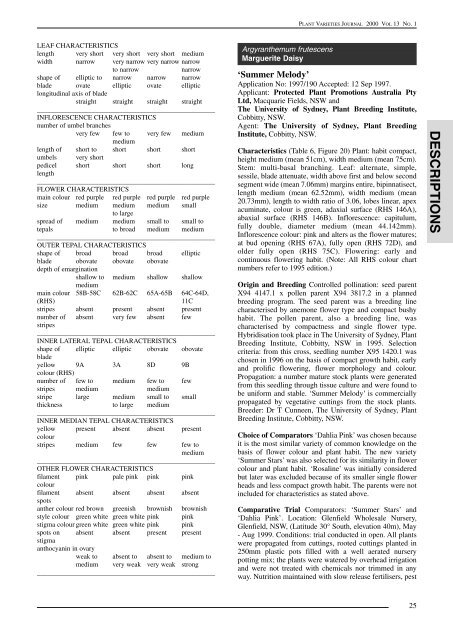53. Volume 13- Number 1 - IP Australia
53. Volume 13- Number 1 - IP Australia
53. Volume 13- Number 1 - IP Australia
Create successful ePaper yourself
Turn your PDF publications into a flip-book with our unique Google optimized e-Paper software.
DESCR<strong>IP</strong>TIONS<br />
PLANT VARIETIES JOURNAL 2000 VOL <strong>13</strong> NO. 1<br />
LEAF CHARACTERISTICS<br />
length very short very short very short medium<br />
width narrow very narrow very narrow narrow<br />
to narrow<br />
narrow<br />
shape of elliptic to narrow narrow narrow<br />
blade ovate elliptic ovate elliptic<br />
longitudinal axis of blade<br />
straight straight straight straight<br />
____________________________________________________<br />
INFLORESCENCE CHARACTERISTICS<br />
number of umbel branches<br />
very few few to very few medium<br />
medium<br />
length of short to short short short<br />
umbels very short<br />
pedicel short short short long<br />
length<br />
____________________________________________________<br />
FLOWER CHARACTERISTICS<br />
main colour red purple red purple red purple red purple<br />
size medium medium medium small<br />
to large<br />
spread of medium medium small to small to<br />
tepals to broad medium medium<br />
____________________________________________________<br />
OUTER TEPAL CHARACTERISTICS<br />
shape of broad broad broad elliptic<br />
blade obovate obovate obovate<br />
depth of emargination<br />
shallow to medium shallow shallow<br />
medium<br />
main colour 58B-58C 62B-62C 65A-65B 64C-64D,<br />
(RHS)<br />
11C<br />
stripes absent present absent present<br />
number of absent very few absent few<br />
stripes<br />
____________________________________________________<br />
INNER LATERAL TEPAL CHARACTERISTICS<br />
shape of elliptic elliptic obovate obovate<br />
blade<br />
yellow 9A 3A 8D 9B<br />
colour (RHS)<br />
number of few to medium few to few<br />
stripes medium medium<br />
stripe large medium small to small<br />
thickness to large medium<br />
____________________________________________________<br />
INNER MEDIAN TEPAL CHARACTERISTICS<br />
yellow present absent absent present<br />
colour<br />
stripes medium few few few to<br />
medium<br />
____________________________________________________<br />
OTHER FLOWER CHARACTERISTICS<br />
filament pink pale pink pink pink<br />
colour<br />
filament absent absent absent absent<br />
spots<br />
anther colour red brown greenish brownish brownish<br />
style colour green white green white pink pink<br />
stigma colour green white green white pink pink<br />
spots on absent absent present present<br />
stigma<br />
anthocyanin in ovary<br />
weak to absent to absent to medium to<br />
medium very weak very weak strong<br />
____________________________________________________<br />
Argyranthemum frutescens<br />
Marguerite Daisy<br />
‘Summer Melody’<br />
Application No: 1997/190 Accepted: 12 Sep 1997.<br />
Applicant: Protected Plant Promotions <strong>Australia</strong> Pty<br />
Ltd, Macquarie Fields, NSW and<br />
The University of Sydney, Plant Breeding Institute,<br />
Cobbitty, NSW.<br />
Agent: The University of Sydney, Plant Breeding<br />
Institute, Cobbitty, NSW.<br />
Characteristics (Table 6, Figure 20) Plant: habit compact,<br />
height medium (mean 51cm), width medium (mean 75cm).<br />
Stem: multi-basal branching. Leaf: alternate, simple,<br />
sessile, blade attenuate, width above first and below second<br />
segment wide (mean 7.06mm) margins entire, bipinnatisect,<br />
length medium (mean 62.52mm), width medium (mean<br />
20.73mm), length to width ratio of 3.06, lobes linear, apex<br />
acuminate, colour is green, adaxial surface (RHS 146A),<br />
abaxial surface (RHS 146B). Inflorescence: capitulum,<br />
fully double, diameter medium (mean 44.142mm).<br />
Inflorescence colour: pink and alters as the flower matures;<br />
at bud opening (RHS 67A), fully open (RHS 72D), and<br />
older fully open (RHS 75C). Flowering: early and<br />
continuous flowering habit. (Note: All RHS colour chart<br />
numbers refer to 1995 edition.)<br />
Origin and Breeding Controlled pollination: seed parent<br />
X94 4147.1 x pollen parent X94 3817.2 in a planned<br />
breeding program. The seed parent was a breeding line<br />
characterised by anemone flower type and compact bushy<br />
habit. The pollen parent, also a breeding line, was<br />
characterised by compactness and single flower type.<br />
Hybridisation took place in The University of Sydney, Plant<br />
Breeding Institute, Cobbitty, NSW in 1995. Selection<br />
criteria: from this cross, seedling number X95 1420.1 was<br />
chosen in 1996 on the basis of compact growth habit, early<br />
and prolific flowering, flower morphology and colour.<br />
Propagation: a number mature stock plants were generated<br />
from this seedling through tissue culture and were found to<br />
be uniform and stable. ‘Summer Melody’ is commercially<br />
propagated by vegetative cuttings from the stock plants.<br />
Breeder: Dr T Cunneen, The University of Sydney, Plant<br />
Breeding Institute, Cobbitty, NSW.<br />
Choice of Comparators ‘Dahlia Pink’ was chosen because<br />
it is the most similar variety of common knowledge on the<br />
basis of flower colour and plant habit. The new variety<br />
‘Summer Stars’ was also selected for its similarity in flower<br />
colour and plant habit. ‘Rosaline’ was initially considered<br />
but later was excluded because of its smaller single flower<br />
heads and less compact growth habit. The parents were not<br />
included for characteristics as stated above.<br />
Comparative Trial Comparators: ‘Summer Stars’ and<br />
‘Dahlia Pink’. Location: Glenfield Wholesale Nursery,<br />
Glenfield, NSW, (Latitude 30° South, elevation 40m), May<br />
- Aug 1999. Conditions: trial conducted in open. All plants<br />
were propagated from cuttings, rooted cuttings planted in<br />
250mm plastic pots filled with a well aerated nursery<br />
potting mix; the plants were watered by overhead irrigation<br />
and were not treated with chemicals nor trimmed in any<br />
way. Nutrition maintained with slow release fertilisers, pest<br />
25

















